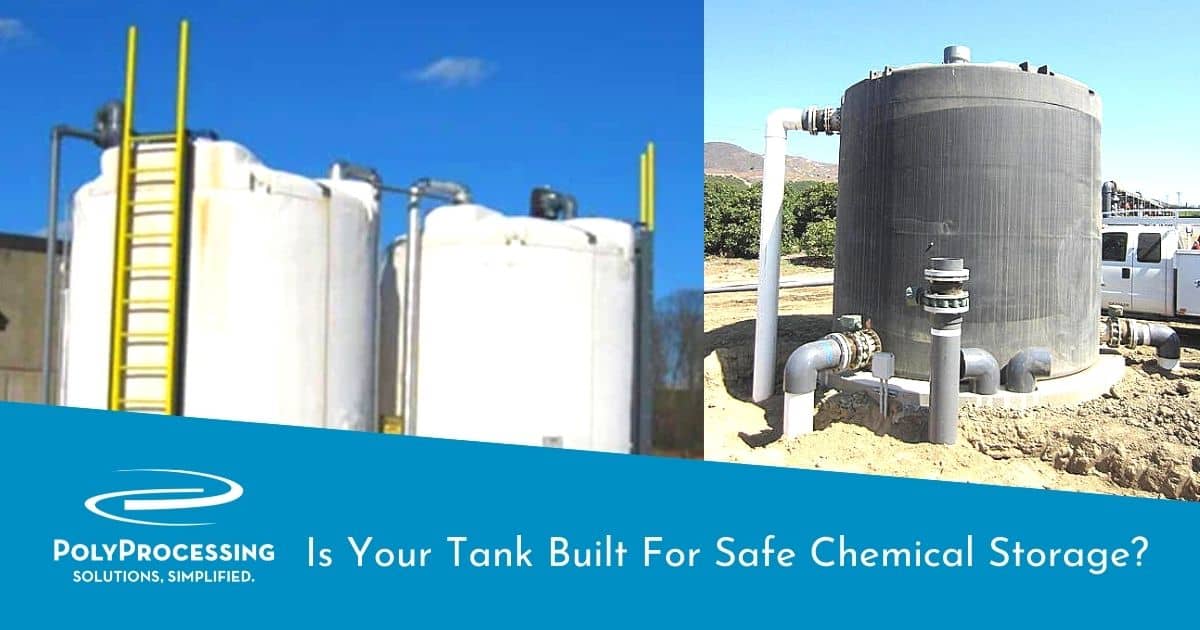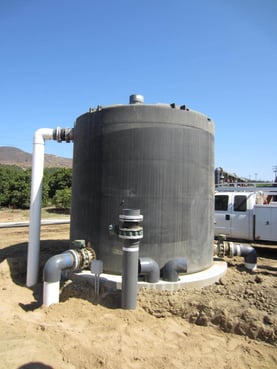Is Your Tank Built For Safe Chemical Storage?
Purchasing the wrong chemical storage tank could be a disastrous decision, so it’s critical to make sure you’re ordering a storage solution that can meet your specific needs.

There are several important factors to consider when you design a polyethylene chemical storage tank for your particular application. Always start the configuration process with the chemical that is being stored, because the chemical’s properties influence the entire tank design, including fittings and accessories, thickness, and materials.
One important consideration is the chemical’s specific gravity. If your chemical tank isn’t rated for the proper specific gravity, you could be looking at costly maintenance and employee injuries. This article will help you ensure that your storage tank will easily handle your chemical’s specific gravity.
What Is Specific Gravity and Why Does It Matter?
Specific gravity is how dense a chemical is, compared to a standard—in our case, water. So, if a chemical has twice the weight as water, its specific gravity is 2.0. If the chemical is 50 percent heavier than water, its specific gravity is 1.5.
Generally speaking, tanks that store water are built to handle a specific gravity rating of between 1.0 and 1.35. Chemicals with a specific gravity outside of this range require a tank that is engineered to handle that type of chemical. If you use a water tank for chemicals with a specific gravity greater than 1.0, you’re putting your equipment and your people at risk.
An inadequate tank can break down, leak, or even fail catastrophically—requiring costly maintenance and placing your employees in danger. When Poly Processing builds tanks to hold a chemical like hydrofluoric acid, we use a specific gravity rating of 1.9 with cross-linked polyethylene resin — not linear polyethylene. We want to assure you a margin of safety and greater useful life.
Temperature Impacts Your Tank’s Specific Gravity Design Rating

A chemical’s specific gravity rating is especially important when you take into account the temperature of the chemical you will be storing. Many projects require chemicals to be stored at a slightly elevated temperature above room temperature. If this is true at your company, it’s very important to understand how temperature affects specific gravity, as well as the design of your tank.
When we design a standard tank, we design it to withstand a maximum temperature of 100 deg F. But in some cases, chemicals may be added to the tank at higher temperatures. These higher temperatures put greater pressure on the tank and increase the hoop stress. It’s critical that the tank wall is designed to withstand greater stress at higher temperatures.
The thickness of a Poly storage tank’s walls can vary to ensure that the tank system is safeguarded from the chemical itself. With some substances, such as sulfuric acid, the heavy weight of the chemical can cause damage to the storage tank’s walls if the tank is not made for the specific substance. Simply put, a heavier chemical, especially at elevated temperatures, requires a thicker tank wall in comparison to simply storing something such as room temperature water.
Poly Processing offers four different standard tank wall thicknesses, depending on your chemical’s specific gravity. As the specific gravity increases, a storage system will require thicker walls to withstand additional stress from the increased temperature and weight.
The maximum service temperature for our crosslinked polyethylene (XLPE) tanks is 150 degrees F, assuming your chemical’s specific gravity is 1.00. Contact us for any unique applications.
You can find out more information about your specific chemical’s fluid specific gravity by checking out our list of commonly stored chemicals.
Will Your Storage Tank Design Work for Your Application?
You need to be confident that your chemical tank storage system meets your application’s requirements. Follow these steps to ensure that you have built a tank system capable of storing your specific chemical:
-
Know the exact chemical name of the substance you plan to store. At Poly Processing, we rely on the chemical’s material safety data sheet (MSDS) to build a tank that matches your specific needs.
-
Find out if the chemical’s temperature will be ambient, and what its variance will be. For substances with a relatively high level of temperature variance, we allow additional tolerance to make sure that the quality of the substance is not compromised.
-
Submit all relevant chemical and storage condition data to one of our tank specialists so that we can verify that you have selected the right tank based on your requirements. We have helped customers develop superior storage solutions for over four decades. Let us help you pick the right tank so that you have total peace of mind about your chemical storage.
Contact a chemical storage expert to determine the specific gravity rating required for your chemical storage application.
- December 20, 2021
- Topics: Chemical Storage
About Poly Processing
Posts By Topic
Tech Talk Podcast Episodes
Subscribe By Email
Recent Posts
- Installation Tips for Chemical Storage Tanks: Site Preparation and Offloading
- Understanding pH and Chemical Concentration When Choosing a Chemical Tank
- Maximizing Fill Efficiency: Selecting the Optimal Fill Line System
- Chemical Storage Tanks: A Quick Guide for End Users
- Popular Customization Options for Chemical Storage Tanks
Tank Configurator

Find the recommended tank and system components for your chemical storage challenge.
Configure a Tank Package





